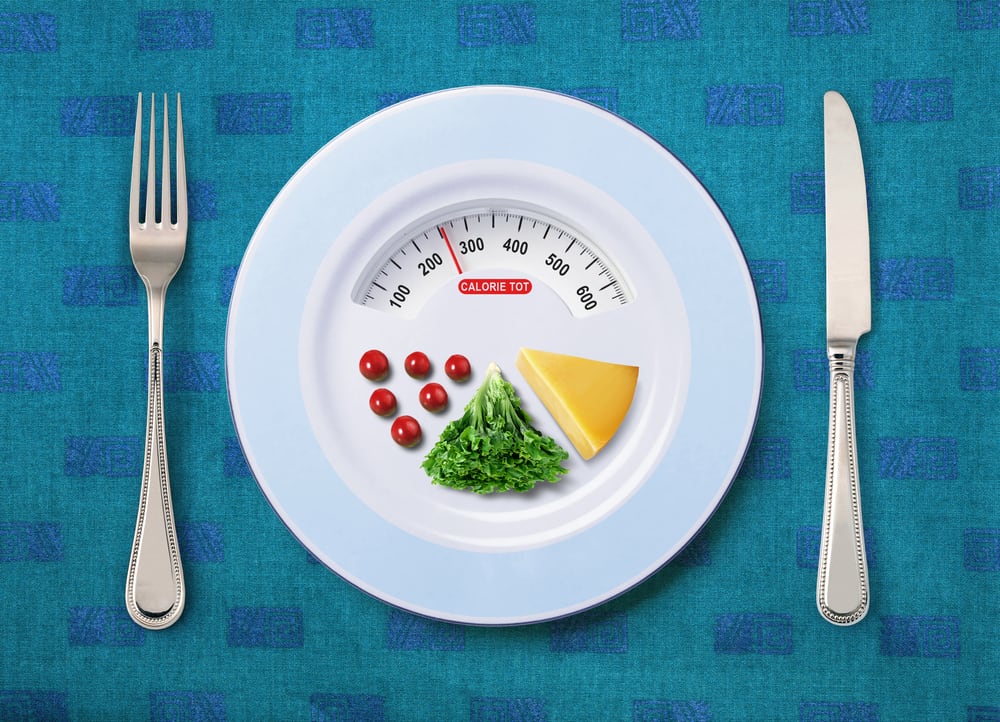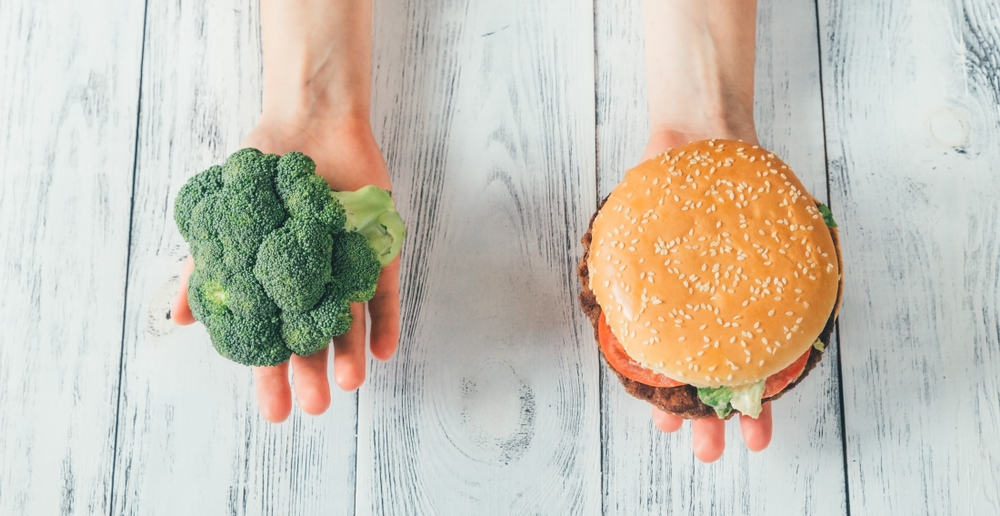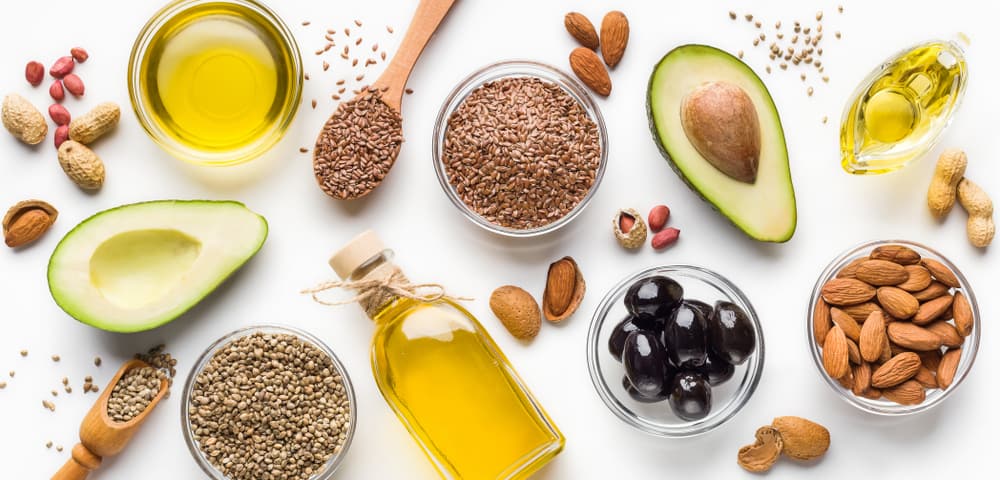Using Calorie Density to Lose Weight
Tracking which foods are low density and which foods are high density can help you lose weight, build better habits, and maintain a healthy weight – but that all starts with understanding the differences between low and high-calorie foods.
What is the “Calorie Density” of Food?

Most foods with high liquid contents will have low-calorie density. Consuming these products will “fill you up” and give you a sense of satiety with a minimal amount of calories.
Some research suggests most people eat the same weight of food at each meal. In other words, they might eat a breakfast that is one pound each time — regardless of what that one pound consists of. For example, eating one pound of bacon will naturally lead you to consume far more calories than eating one pound of broccoli, which has a much lower caloric density.
This is why it is recommended for those trying to lose weight or maintain a healthy weight to fill most of their plate with low-calorie density foods. However, some medium or high-density calorie foods may also be acceptable.
As previously seen, calorie density may also be referenced as “low energy density” or “high energy density” foods. Here, energy density refers explicitly to caloric intake.
A great example is comparing soup to pudding. A cup of Campbell’s tomato soup contains 60 calories — compared to a cup of chocolate pudding, which has 120 calories. Tomato soup is, compared to chocolate pudding, a low-energy-density food.
A study published in the International Journal of Obesity (London) noted that reduced energy density did have a positive impact on weight loss. For those trying to lose weight, monitoring the calorie density of food can be an easy way to reduce the number of calories in and calories out.
However, because the calorie density of food doesn’t necessarily relate to nutritional density, those on a diet should also take the extra step to make sure that they are eating a balanced diet. The Mayo Clinic notes that people should still focus on the food pyramid to capture nutrients rather than calories. The Mayo Clinic further notes that fruits, vegetables, protein, and dairy are some of the healthiest foods that may also have a low-calorie density.
According to research published in The New England Journal of Medicine, many people vastly underestimate their caloric intake, and therefore the number of calories within most foods. Due to this, individuals may not want to rely upon their own assessment of low-calorie density or high-calorie density foods.
For example, an entire cup of whipped cream is 154 calories — nearly the same number of calories in a cup of whole milk. According to a scientific study titles”Liquid calories and the failure of satiety: how good is the evidence?” in Obesity Reviews, liquid calories tend to be difficult for people to track and often contribute to higher levels of weight gain or weight maintenance. Liquid calories may also not trigger feelings of satiety as much as non-liquid calories.
Eventually, many will learn to intuit their intake and know the general “rules” of food. Clear liquids such as broths and clear soups tend to have lower calories, for instance, because other soups are milk and flour-based. Until then, apps and other calorie trackers can be used to identify the foods that will be low in caloric density.
Want to try using calorie density to help you reach your health and wellness goals? That’s exactly what Noom helps with. All subscriptions come with a personal coach, group coach, and more. Check out free trial offer to try it for yourself.
How Does “Calorie Density” Help You Lose Weight?
Ultimately, calorie density aims to achieve the feeling of satiety with fewer calories — which is the same goal as many different diets. However, learning about calorie density helps individuals on a diet adjust to the fact that most people will eat until they are “full.” If they can feel full faster through lower-calorie foods, then they are less likely to overeat.
A meta-analysis published in Nutrients covering 3,628 subjects between the ages of 18 to 66 found a direct correlation between low energy foods and bodyweight reduction. According to the study, those who ate foods that were low in calorie density were more likely to lose weight.
This is compelling research that indicates that calorie density can help people lose weight. Let’s take a look at some of the benefits of calorie density.
First, individuals are eating the same amount of food, rather than lessened amounts of food. This can help individuals feel less like they are being deprived and improve upon the consistency of the diet.
A pound of cheeseburger has a significantly different nutritional profile and caloric density than a pound of carrots, even though they will leave people similarly full. Likewise, most people aren’t going to start overeating once they’ve eaten a pound of carrots, which is because the feeling of satiety will lead to discomfort if the individual keeps eating.
Second, individuals can control how many calories they eat without too much trouble. Once they learn what low-calorie density foods are, they can begin to consume them regularly. This cuts a lot of the guesswork and calorie counting out of the diet.
By eating low-calorie density foods before they eat a meal, they can decide to eat healthy for the rest of that meal because they are unlikely to force themselves to eat past the full feeling.
Finally, individuals can still eat small amounts of high-calorie density foods as long as they eat a significant amount of low-calorie density foods, making them feel less deprived while on a diet. When people aren’t able to eat the foods they really love, they are much less likely to stick to a diet and are far more likely just to give up altogether.
A calorie-density-focused diet can be sustainable and help build habits that can last longer than a fad or a trend diet. Furthermore, there are some concerns about the long-term effects of many fad diets, which could be unpredictable due to nutritional content.
As noted by the Mayo Clinic above, a well-rounded diet can still be achieved through the use of a low energy density diet, which may not be the case with many exclusion-based fad diets.
Do Low-Calorie Density Foods Reduce Hunger?
A major draw of calorie density for weight loss is that the strategy (ideally) leaves the subject without hunger. Since individuals would still be eating the same weight of food throughout, they will still feel sated.
During dieting, hunger can play a significant role, according to the Journal of Nutritional Science. The more hungry a person feels, the more likely their diet is to be sabotaged because they will not be able to stick to it.
In a study published in The Journal of Nutrition, it was discovered that not only did those on low-calorie density foods lose weight, but they also felt that they had more control over their eating. They reported that they had fewer cravings and had more motivation to continue their diet program.
This is very important when it comes to losing weight. If a diet program can’t be stuck to, it’s easier to “yoyo diet” – though one study published in Obesity (Silver Spring) argued that yoyo dieting is still better than not dieting at all.
According to the International Journal of Exercise Science, it’s currently unclear whether yoyo dieting, also known as “weight cycling,” could pose a significant risk of health issues. Still, it doesn’t make it so that people can meet their weight goals.
In one study published in Appetite, men and women were given low-calorie or high-calorie puddings or jellos and directed to eat as much as they liked. These foods seemed to have equal amounts of satiety despite those within the low-calorie dense group eating fewer calories.
This indicated that eating low-calorie density foods when eaten to satiety did not make it likely that someone might overeat later on. In other words, it reduced the total amount of calories that the group ate.
In other tests, drinking water also helped individuals lose weight — and water can be considered the most low-energy-density product consumable. In another study published in Physiology & Behavior, those who drank a glass of water with every meal consumed 26 percent less in calories and rated themselves as being less hungry after eating. Eating foods that are higher in water may have a similar effect on those who are trying to reduce the overall amount of food they are consuming.
Many studies, including one published in The Journal of the International Federation of Clinical Chemistry and Laboratory Medicine, have shown that the energy density of food can affect the number of calories taken in and the feelings of hunger and satiety. Not only does this make this type of diet effective, but it also makes it more comfortable to follow.
Want to be sure you’re keeping your calorie density in a healthy range? The Noom app can help you track your daily intake to promote sustainable weight loss.
Can Low-Calorie Density Foods Help Keep the Weight Off?
Some diets will help people take the weight off but not keep the weight off. This is a potential issue with weight cycling.
In a study titled “Consequences of Weight Cycling: An Increase in Disease Risk?” that was published in the International Journal of Exercise Science, researchers explored the pro-inflammatory response to weight cycling as well as the issues that could cause repeated weight gain.
However, since the low-calorie-density foods can be incorporated into habits and a healthier attitude toward food, they have been associated with successful weight loss and maintenance in some research published in the Journal of the American Dietetic Association.
Ideally, weight loss should be “continuous, easy to comply with, and of low energy density,” according to one study published in Healthcare. These are things that low-calorie density foods can achieve. Individuals can continue low-calorie density foods permanently because they can still eat what they want. Instead, they just have to eat smaller quantities of high-calorie density foods.
Further, individuals can easily comply with this because they start to intuitively know which foods will be lower in calorie density and learn the calorie density of different foods.
Additionally, because low-calorie density meals can also be augmented with water, it’s easier to continue to comply with this kind of diet. Those who eat high calorie or moderate calorie density foods can also supplement with water to make their meal as a whole lower calorie density.
While many people can lose weight temporarily, research published in The Medical Clinics of North America notes that maintaining that weight loss can be far more challenging. For those who are countering obesity, it appears that long-term strategies and long-term changes may need to be made.
Thus, a one-time diet that cannot be permanently followed may not be the best solution. Instead, individuals need to be able to focus on long-term changes in their diet and nutrition plans.
A year-long trial published in the American Journal of Clinical Nutrition compared two different types of weight loss. One group reduced fat intake while another group reduced fat intake and ate water-rich foods. Beyond this, there were no instructions – they just adhered to these diets and then recorded the results.
Both groups did lose weight, but the group that reduced fat intake and ate water-rich foods reported lower hunger levels. They also ate more fruits and vegetables, which can be considered positive nutritionally.
How Can You Achieve a Low-Calorie Density Diet?
Low-calorie density food diets begin with tracking the calorie density of foods and choosing foods with fewer calories relative to their weight. There is no specific cut off for low-calorie food, so on a practical level, it could be called lower calorie density foods.
Low-calorie density foods tend to be things like soups, salads, vegetables, and fruits. These kinds of low-calorie density foods are almost universally water-rich foods. According to Nutrition Bulletin, water is 0 calories a gram, and fat is nine calories a gram, creating a spectrum between water content and fat content.
First, many who follow a low-calorie diet will eat something with high water content before eating their main course, which can encourage them to feel sated without overeating their main course.
Soups, salads, and fruits can be eaten before a meal. Alternatively, a glass of water may be drunk before a meal as well. Either way, this could reduce the number of calories eaten throughout the meal.
The ultimate goal for a low-calorie density diet is to be eating a volume of low-calorie density foods in place of a similar volume of high-calorie density foods. Some research has indicated that people will largely consume a similar weight of food regardless of the calorie density, so it’s less likely that someone will find a way to substitute these calories while eating. Rather, they are likely to eat lower calories in general without feeling hungry later.
Those trying to achieve a low-calorie density diet may start tracking the calorie densities of their foods first. Some apps help with tracking foods by calorie density.
Since people tend to be very poor at estimating the number of calories they eat, according to research published in Medicine and Science in Sports and Exercise, the first step is to become more aware of how many calories are in each food. Beyond that, it’s being aware of water-rich food and choosing to eat water-rich foods rather than high-fat foods.
As a low-calorie density diet is meant to be a diet that is maintained, it’s not ideal that subjects completely stop eating high-calorie density foods. Instead, it’s generally recommended that the majority of foods be low-calorie density rather than all foods.
This may be enough to supplant the amount of high-calorie density foods in a person’s diet previously, which can still provide some advantages in a caloric loss.
Are Low-Calorie Density Foods Healthier?
It’s not necessarily true that low-calorie density foods are innately healthier, but they do tend to be fruits, vegetables, and other high-nutrition and low-fat products.
People are often urged when dieting to focus not just on weight loss but also on nutritional value. High-quality foods include vegetables, fruits, grains, and healthy proteins, according to Harvard University. Low-quality foods are snack foods, sweetened beverages, foods with added sugar, and foods high in fats.
Many low-calorie density foods are healthier, and eating a low-calorie diet itself can be beneficial. One study published in CMAJ showed a low-calorie diet could reduce body weight and maintain weight loss over five years. Low-calorie density diets are essentially a method of achieving a low-calorie diet by reducing total calories consumed without discomfort.
Many scholars, including some from research published in Current Obesity Reports, blame processed foods for the obesity epidemic. People can eat what seems like a reasonable amount of food with twice as many calories as comparable unprocessed foods.
Because of added sugars, salts, and fats, people begin to crave these ultra-processed foods — and it’s very easy to eat too much of these because they are packed with calories. Calorie-dense foods, therefore, while not inherently unhealthy, should be eaten sparingly. This is in contrast to them often being eaten with every meal in a modern diet.
There are some significant health impacts of obesity, according to the Pakistan Journal of Medical Sciences. Losing weight through low-calorie density foods can reduce obesity impacts as it directly treats obesity and being overweight.
While not all obese or overweight people may experience these health impacts, these health impacts are more likely with increased weight gain. According to Pharmacoeconomics aging increased weight gain has become an epidemic for a variety of reasons, including an increasingly sedentary lifestyle, processed foods, and mechanized transport. While a low-calorie density food cannot counter all these issues, it can help alleviate weight gain.
There is, as noted, causes a significant overlap between nutritionally valuable foods and low-calorie density foods, particularly fruits and vegetables. The ideal beverage will always be water, something that is encouraged in a low-calorie density diet.
A concern during a low-calorie density diet could be that a focus on high water content foods could eliminate some nutritional value caused by eating fruits and vegetables exclusively. However, a low-calorie density meal plan can work hand-in-hand with the food pyramid and nutritional value.
However, it isn’t just about a low-calorie density diet – it’s about reducing calories overall. Studies, particularly one published in Antioxidants & Redox Signaling, have shown that reducing caloric intake, in general, can produce longevity in many animals and even people. Consuming fewer calories while still maintaining basic nutrition reduces the amount of work the body has to do and ultimately reduces aging signs and symptoms.
Other studies have pointed out that exceptionally long-lived individuals tend to be on comparatively restrictive diets, such as the elders in Okinawa. While there haven’t been extensive studies in this area yet, findings are positive that consuming less, over time, can not only reduce weight but improve aging.
Noom helps you learn to make better choices by using a color-coded system, based on caloric-density. The green foods are low-calorie density and encouraged, but no food is ever off-limits.
Criticisms of Low-Calorie Density for Weight Loss
There are some potential criticisms of using calorie density for weight loss, but most of these relate directly to focusing solely on calorie density to the detriment of other nutritional concerns.
First, some studies, including one published in Perspective on Psychological Science, have questioned whether reducing calories always leads to weight loss. It’s theorized that a short-term reduction in calories can cause an individual’s metabolism to become slower to compensate, with the human body being particularly efficient.
Therefore, though the individual might lose weight short-term, they may not lose weight long-term because their body will become more efficient to match the amount of energy it has been given.
While there have been studies and theories to this effect, it is not generally considered to be significant in most. According to The Journal of Clinical Endocrinology & Metabolism, metabolic shifts have been seen in patients with severe obesity, but the metabolic shift is temporary, as per Obesity (Silver Spring).
Either way, metabolic shifts do not mean that CICO (calories in calories out) doesn’t work. It simply means that even fewer calories will need to be eaten to continue weight loss — something that low-calorie density foods can help.
It is still potentially possible to overeat even with low-calorie density foods. Those who are snacking all day may still eat more than they should in even fruit and vegetables. Because it’s only “calories in calories out” that matter, over-eating low-calorie density foods will still encourage weight gain.
It’s important to make the distinction between low-calorie foods and low-calorie density foods. A rice cake, with 50 calories, is a low-calorie food, but it’s extremely light and insubstantial. A single cake is only 0.5 ounces, and 16 ounces of rice cake would be 1,743 calories.
Meanwhile, 16 ounces of Campbell’s Tomato Soup would be 208 calories. This is a vast difference. Tomato soup is a low-calorie density food and would leave a person feeling far more sated than someone who had eaten a single rice cake — and if someone attempted to eat an equal amount of rice cake because they were still hungry, they would overeat.
While there are some criticisms of using calorie density for weight loss, ultimately, it’s one of the best methods. It’s been shown to be effective when studied in groups, it’s easy to do, and it’s simple to maintain.
Compared to fad diets, it’s something that is healthier and leaves the door open for a healthy and sustainable diet, rather than a cyclic dieting cycle. Since low-calorie density foods will ultimately help with weight loss and maintenance of that weight loss, they can improve an individual’s health.
Further, low-calorie density foods have very few potential side effects. As an example, the ketogenic diet comes with numerous side effects because it is often not a balanced diet and can leave people nutritionally lacking and deprived, though it can also be effective according to StatPearls.
However, the low-calorie density diet does not inherently include any deficiencies the way that a fad or an elimination diet might. This makes it an ideal solution for those who are looking to lose weight and improve their health and diet at the same time.
What Foods Are Low in Energy Density?
What foods are low in energy density? It’s not always something that is intuitive. As with the rice cake example, low-calorie foods may not necessarily be low in caloric density. Some foods that are low in energy density include:
- Fruit such as apples, oranges, bananas, and berries.
- Vegetables such as broccoli, lettuce, zucchini, and squash.
- Whole grains such as quinoa, sorghum, rye, and corn.
- Beans such as peas and lentils.
Generally, those low in energy density are going to be unprocessed or minimally processed. Many processed foods have fats or sugars added to them, and any added fats or sugars will ultimately add to the calorie content.
It should be noted that there are some healthy foods that are dense in energy. These foods shouldn’t be avoided altogether; it’s simply that they should be reduced compared to low energy density foods. Some high energy density foods include:
- Peanut butter and nuts such as almonds and cashews.
- Cheese products, including most types of cheese.
- Eggs, whether hard-boiled or fried.
- Avocados, which have healthy fats.
These are foods that have high levels of protein and healthy fats and are thus still part of a healthy diet.
However, because they are high energy density foods, they should not be eaten with every meal or should be eaten after consuming low energy density foods. High-fiber foods can also indicate low energy density foods. Popcorn is a good example of a low energy density grain.
If you’re ready to track your food intake and learn about caloric density, we recommend Noom. Right now, the company is giving all DietSpotlight readers free trial offer. Check it out!
Conclusion: Using Calorie Density for Weight Loss
There are many people today who are focusing on low-calorie density foods rather than low-calorie foods. There are numerous advantages to doing so. While low-calorie foods may leave people feeling as though they are still hungry, low-calorie density foods are geared toward providing a sense of satiety.
While calorie density isn’t the only solution to weight loss (eating too many calories is still possible), it creates a roadblock against eating too much — because of the quantity of food eaten. When paired with intelligent eating and good nutrition, it can be the foundation for a healthy, long-term diet.
At the same time, those following a low-calorie density weight loss campaign should still make sure that they’re eating healthy foods and that they aren’t skipping any nutrients they need.
To begin with a low-calorie density weight loss program, people can start by adding more water into their diet in general. From there, they can begin eating low-calorie density foods like fruits, vegetables, and salads before their main course. They may even find that this is enough to deter them from eating high-calorie entrees or over-eating during meals.

Summer Banks has researched over 5000 weight-loss programs, pills, shakes and diet plans. Previously, she managed 15 supplement brands, worked with professionals in the weight loss industry and completed coursework in nutrition at Stanford University.


